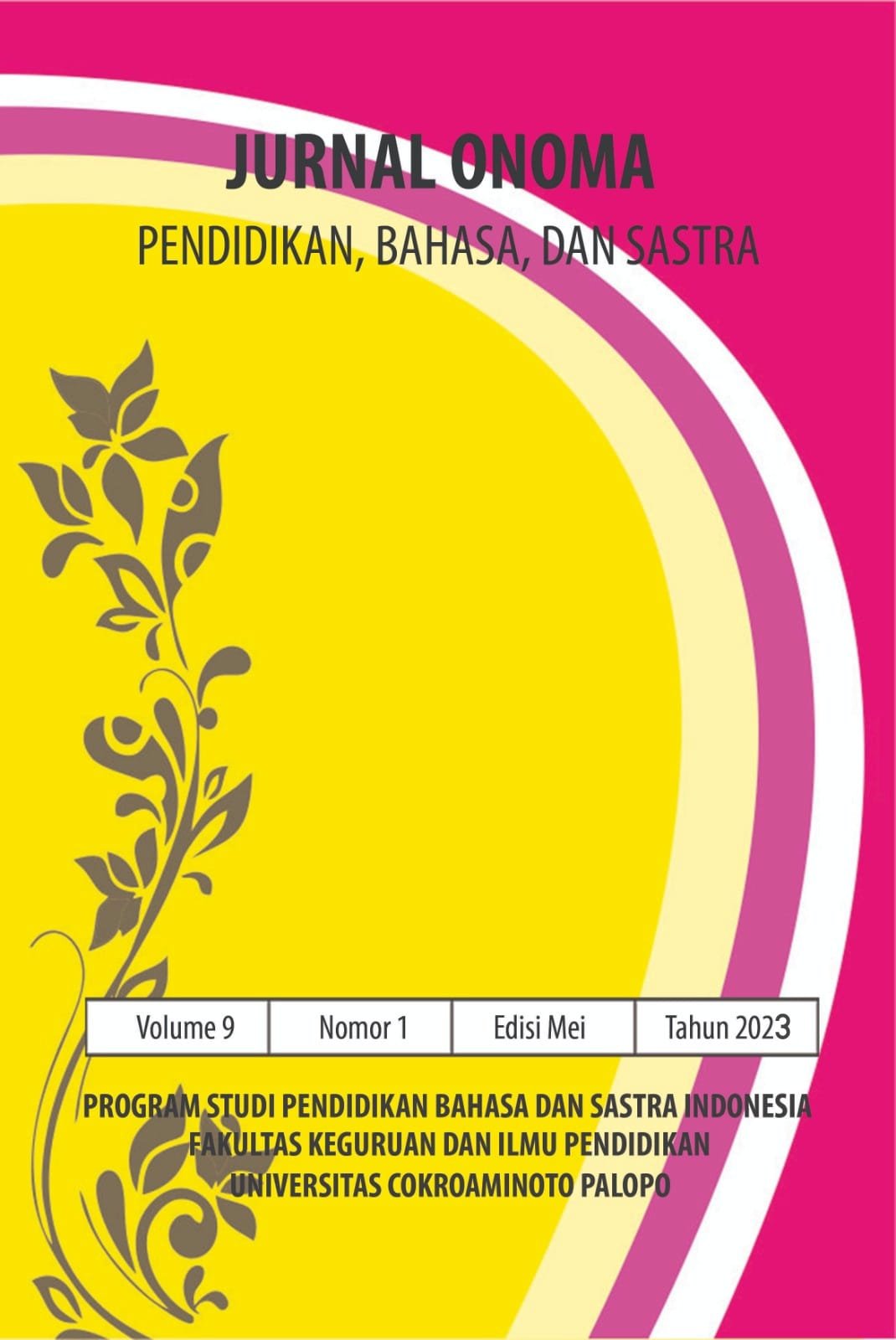Magical Realism in Toshikazu Kawaguchi's Before The Coffee Gets Cold
https://doi.org/10.30605/onoma.v9i1.2353
Keywords:
magical realism, ghost, JapanAbstract
This study discusses magical realism in Toshikazu Kawaguchi's Before The Coffee Gets Cold. The aims of this study are to find the characteristics of magical realism and to explain the significance of utilizing the magical realism portrayed in the novel. The method applied is descriptive qualitative by presenting dialogues and narration relating to the topics of this study. The results found are that there are five characteristics of magical realism in the novel; 1) the irreducible elements of magic, 2) the phenomenal world, 3) unsettling doubts, 4) merging realms, and 5) the disruption of time. It is also found that the time-travelling and the ghost presented in the novel are significant for utilizing magical realism to explore and understand reality from a different point of view as well as to criticize perceived, knowable reality.
keywords: magical realism, ghost, Japan
Downloads
References
Abrams, M. H., & Harpham, G. G. (2012). A glossary of literary terms. Cengage Learning.
Asmida, E. (2020). Magical realism in Audrey Niffenegger’s The Time Traveler’s Wife. Eralingua: Journal Pendidikan Bahasa Asing dan Sastra, 4(1), 39-53. https://ojs.unm.ac.id/eralingua DOI: https://doi.org/10.26858/eralingua.v4i1.11891
Bowers, M. A. (2004). Magic(al) realism: The new critical idiom. Routledge. DOI: https://doi.org/10.4324/9780203625002
Suparman, N. F. N. (2018). Glotokronologi Bahasa Rampi Dan Bahasa Wotu Glotocronology Language Rampi And Wotu Languages. Telaga Bahasa, 6(1). DOI: https://doi.org/10.36843/tb.v6i1.15
Carlsen. L. M. (2018). The house of the Japanese Spirits: Orientalism and Magical Realism in Isabel Allende’s El amante japonés. Transmodernity: Journal of Peripheral Cultural Production of the Luso-Hispanic World, 8(1), 104-122. https://doi.org/10.5070/T481039388 DOI: https://doi.org/10.5070/T481039388
Faris, W. B. (2004). Ordinary enchantments: Magical realism and remystification of narrative. Vanderbilt University Press. DOI: https://doi.org/10.2307/j.ctv17vf68f
Hasanah, S., Kuncara, D. S., & Astuti, D. A. (2021). Magical realism in Neil Gaiman’s The Ocean at The End of The Lane novel. Ilmu Budaya: Jurnal Bahasa, Sastra, Seni, dan Budaya, 5(2),404-420. http://e-journals.unmul.ac.id/index.php/JBSSB%20
Hegerfeldt, A. C. (2005). Lies that tell the truth: Magic realism seen through contemporary fiction from Britain. Rodopi. DOI: https://doi.org/10.1163/9789401202831
Suparman, N. F. N., & Nurliana, N. F. N. (2022). SISTEM FONOLOGI BAHASA TAE (The Phonology System of Tae Language). Kandai, 18(1), 44-60. DOI: https://doi.org/10.26499/jk.v18i1.3450
Mayer, I. (2018). Dreaming in isolation: Magical realism in modern Japanese literature. Carnegie Mellon University. Thesis. https://doi.org/10.1184/R1/6685166.vl
Napier, S. J. (2005). The fantastic in modern Japanese literature: The subversion of modernity. Taylor & Francis e-Library. DOI: https://doi.org/10.4324/9780203974636
Kawaguchi, T. (2019). Before the coffee gets cold. Picador.
Ouyang, W. (2005). Magical realism and beyond: Ideology of fantasy. In S. M. Hart & Wen-Chin Ouyang (Eds.), A companion to magical realism (pp. 13-20). Tamesis.
Sasser, K. A. (2014). Magical realism and cosmopolitanism: Strategizing belonging. Palgrave Macmillan. DOI: https://doi.org/10.1057/9781137301901
Taylor, R. (1981). Understanding the elements of literature: Its forms, techniques and cultural conventions. Macmillan Press.
Thamarana, S. (2015). Magic realism in English literature and its significant contribution. International Journal of English Language, Literature, and Translation Studies (IJELR), 2(4), 263-266.
Wati. I. M., & Ayu, H. R. (2019). Magical realism in Riggs’ Miss Peregrine’s Home For Peculiar Children. LITERA KULTURA: Journal of Literary and Cultural Studies, 7(1), 1-8. https://doi.org/10.26740/lk.v7i1.29485
Zamora, L. P. (1995). Magical romance/Magical realism: Ghost in U.S. and Latin American fiction. In L. P. Zamora & W. B. Faris (Eds.), Magical Realism: Theory, History, Community (pp. 497-550). Duke University Press DOI: https://doi.org/10.1215/9780822397212-025
Downloads
Published
How to Cite
License
In submitting the manuscript to the journal, the authors certify that:
- They are authorized by their co-authors to enter into these arrangements.
- The work described has not been formally published before, except in the form of an abstract or as part of a published lecture, review, thesis, or overlay journal.
- That it is not under consideration for publication elsewhere,
- That its publication has been approved by all the author(s) and by the responsible authorities – tacitly or explicitly – of the institutes where the work has been carried out.
- They secure the right to reproduce any material that has already been published or copyrighted elsewhere.
- They agree to the following license and copyright agreement.
License and Copyright Agreement
Authors who publish with Onoma Journal: Education, Languages??, and Literature agree to the following terms:
- Authors retain copyright and grant the journal right of first publication with the work simultaneously licensed under Creative Commons Attribution License (CC BY 4.0) that allows others to share the work with an acknowledgment of the work's authorship and initial publication in this journal.
- Authors are able to enter into separate, additional contractual arrangements for the non-exclusive distribution of the journal's published version of the work (e.g., post it to an institutional repository or publish it in a book), with an acknowledgment of its initial publication in this journal.
- Authors are permitted and encouraged to post their work online (e.g., in institutional repositories or on their website) prior to and during the submission process, as it can lead to productive exchanges, as well as earlier and greater citation of published work.

















